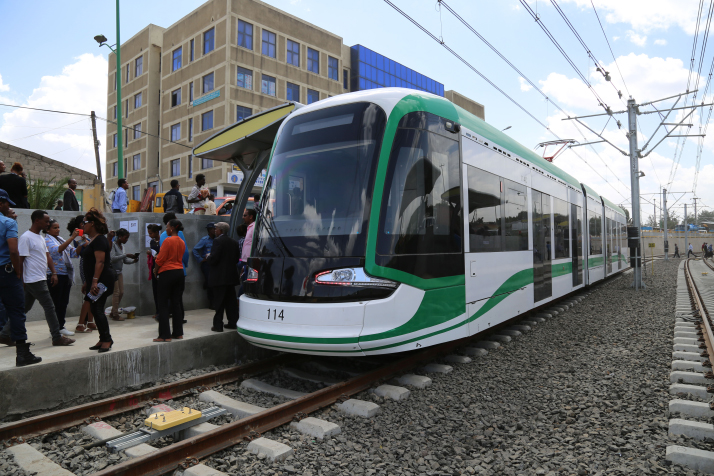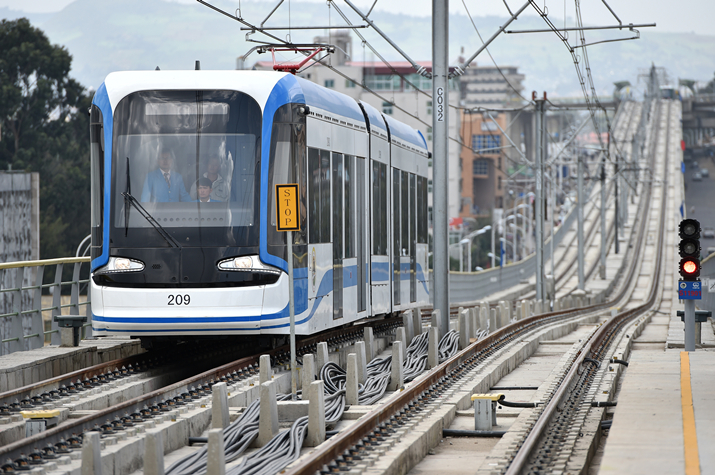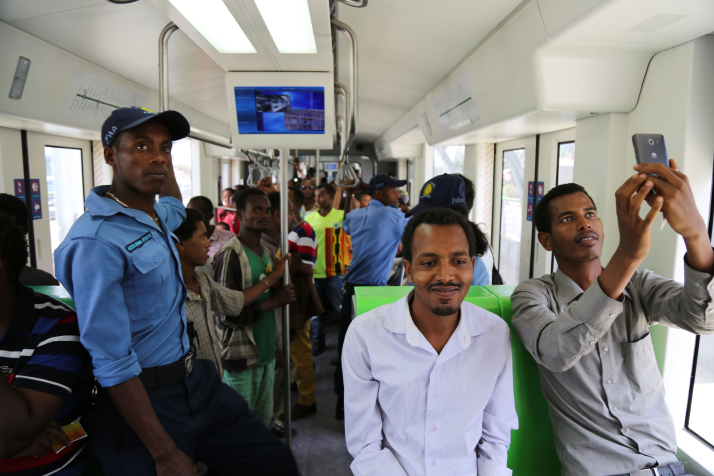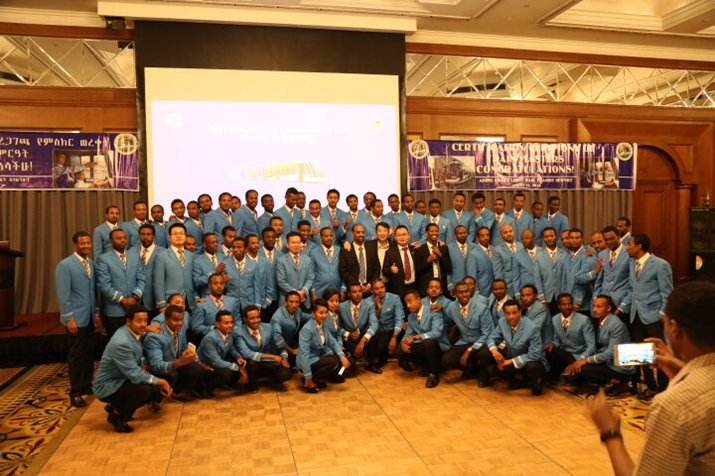|
||||||||||
| Home Nation World Business Opinion Lifestyle ChinAfrica Multimedia Columnists Documents Special Reports |
|
||||||||||
| Home Nation World Business Opinion Lifestyle ChinAfrica Multimedia Columnists Documents Special Reports |
| Africa |
| All Aboard |
| Chinese-built light railway offers Addis Ababa commuters a more convenient and affordable transport option |
| By Xia Yuanyuan | VOL.9 December 2017 ·2017-12-11 |

Light railway cuts commuting time in Addis Ababa
A 13-month annual calendar, the world's best coffee and a plethora of subterranean rock-carved churches, these are just some of the things that make Ethiopia unique. Now the country, located in the Horn of Africa, has a new feather in its cap.
Cutting through the heart of its booming capital Addis Ababa, the Light Rapid Transit (AALRT) network, the first of its kind in Sub-Saharan Africa, has quickly become a source of national pride.
With its cost of $475 million partly funded by the Export-Import Bank of China, the urban railway project has been touted as the solution to the city's growing road transport problems since it began operation in 2015.
One line, featuring blue carriages, covers 16.69 km and runs north to south, serving 20 stations from Menelik to Kaliti. A second green carriage line stretches 17.02 km and runs east to west, linking Ayat to Tor Hailoch. The two lines include 39 stations.
"It is modern and comfortable," Goody Kunambuta, a local resident, told ChinAfrica. "The railway totally changed our lives," he added. The railway's operating hours of 6 a.m. to 10 p.m. has also meant a boost for the local economy. Previously, the city streets were all but deserted around 8 p.m., but the convenience of the new lines has transformed the city center into a bustling crowded area right up to the time of the last train.
A new traveling option
"Woraj (meaning to get off in the local language)" is a cry heard across the city from passengers pouring out of minibus taxis.
In Addis Ababa, blue and white minibuses are the most popular means of public transport. Though the fares are cheap, most of these vehicles are old and dilapidated. The symbolic blue colored Lada taxis provide another commuting option, but with a high cost.
"The light railway provides us a new means of transportation. It is highly cost-effective," Getnet Bayih, a local variety store owner, told ChinAfrica. Living in a suburb 15 km from the city center, He spends 10 birr ($0.43) by minibus to his office. The trip includes several transfers. A taxi would set him back 200 birr ($8.7). "If I take the light railway, I only pay 6 birr ($0.26), for a journey with no transfer stops," said Getnet. "It is definitely faster, cleaner and more comfortable."

Blue carriages of Addis Ababa light railway
Ethiopia is the second most populous country in Africa. According to Ethiopia's Central Statistical Agency, the population of Addis Ababa has reached 4.6 million this year. Transportation needs in the city are increasing exponentially in relation to its population growth and economic development. The rail service, estimated to transport about 100,000 passengers daily, helps ease congestion in an often grid-locked city.
Every day, 244 trains shuttle across the city, while every 15-20 minutes, a train departs from the central station.
"By the end of August, more than 4.1 million km of rail trips had been made, transporting 73 million people," said Yang Xiaohui, Chief Engineer of China Railway No.2 Engineering Group (CREGC), the Chinese company that constructed the light railway.
"It [AALRT] contributes a lot. Instead of waiting in a long queue for the minibus, people now have an alternative," said Goody.
Green transportation
In Addis Ababa, the strong smell of diesel fumes belching out of the exhaust pipes of minibuses and taxis is a major air pollution concern for the city.
According to the Addis Ababa Greenhouse Gas Emission Inventory of 2012, transport vehicles accounted for 47 percent of the 4.8 million tons of carbon dioxide gas emitted.

"The electrified light-rail transit system is helpful in reducing the city's air pollution by using clean energy," said Yang. The rail system cuts the city's emissions while also being an affordable option for 60 percent of the city's residents who would otherwise be walking, he added.
In 2016, Addis Ababa was one of the 10 recipients to receive the prestigious C40 Cities Awards 2016 in global recognition of cities that are demonstrating climate action leadership. The award acknowledged its development in the transition from diesel-fueled public transportation to more ecologically-friendly forms of transport.
The cumulative emission reduction potential of the AALRT system is forecasted at 1.8 million tons of carbon dioxide gas by 2030, according to the C40 Cities Awards sponsor Bloomberg Philanthropies and Chinese green-tech developer BYD.
Localization
From construction to management and operation, the AALRT project focused on localization.
"The building materials of the project were purchased from local markets, such as construction equipment and cement, which contributed to promoting the development of local construction, manufacturing, transportation and leasing industries, as well as wholesale and retail trade," said Yang. In addition, Ethiopian Prime Minister Hailemariam Desalegn said while the railway project helps Ethiopia's traffic progress, it also promotes technology transfer and management exchange between the Chinese and Ethiopians.

More than 130 locals have received their light railway driving licenses
After its successful inauguration in 2015, Shenzhen Metro Group began to operate the project jointly with CREGC. They reached a 36-month agreement with Ethiopia. After the agreement expires, the railway operation will be handed over to Ethiopia Railways Corp. along with transferring management expertise and training local drivers, which will be completed next year.
The project has created 13,000 jobs, with more than 400 local technicians enrolled in Chinese universities and institutions to receive professional training. Now, more than 130 locals have received their light railway driving licenses and the urban rail transit management system has been also established.
Not everyone happy
Since it began operation, some skeptics argue that the light railway causes traffic jams, and for many residents, the city's network of overcrowded minibus taxis remains the only option.
"Sometimes, it takes up to 20 minutes to wait for a train, and it is crowded especially in peak hours. This causes complaints," said commuter Tseyon Dejene, a hotel assistant manager.
"The current section is just the first phase of the project, and it only eases 10 percent of the transportation pressure of the city, so more trains are needed," said Yang. "We can't expect one railway to solve a city's transportation problem."
The next phase of the project is currently waiting for funding. Some observers even blamed the light railway for increasing traffic. While the tracks are elevated in parts of the city, in some traffic circles, they cut between and through lanes of cars, leaving thoroughfares snarled with vehicles. But according to Yang, measures were taken to extend and widen the roads in these hotspots, with a recommendation to convert the traffic circles to traffic light intersections.
Yang also pointed out that traffic congestion in a city is caused by many factors, such as poor transportation facilities, unreasonable urban traffic planning, slow development of public transport and other factors.
He believes the lack of parking space is a major problem resulting in Addis Ababa's traffic chaos. "Only with an overall upgrade in its urban planning, can the city's traffic conditions be improved," he said.
(Reporting from Ethiopia)
| About Us | Contact Us | Advertise with Us | Subscribe |
| Copyright Beijing Review All rights reserved 京ICP备08005356号-5 京公网安备110102005860号 |